Hanan Qureshi Travel Fellowship Report
Vancouver and Whistler, 23rd June – 18th July
“Architects are the main problem.” I was shocked. This was Doug Gayton, Assistive Technology Consultant at GF Strong Rehabilitation Centre in Vancouver. He was replying to my query about the reasons of inaccessible environments. Architects- he went on to explain, in order to design grand buildings- create inaccessible spaces. As an example to the contrary, he referred to the architecture of the rehabilitation center where we were having this conversation. The building, he told me, was designed with the primary aim to facilitate the movement of people with disabilities. In particular, he pointed that the entrance to the rehabilitation center did not need any ramps as there was no change in the floor level. After a long and fruitful discussion about the evolution of Vancouver as an accessible city with Doug and his team, I left the center for Vancouver City Hall – home of the Vancouver City Council – to look for drawings of retrofitted spaces throughout the city.
Earlier that day, I had reached GF Strong Rehabilitation Centre, situated in a quiet neighborhood of Vancouver, from the campus of University of British Columbia without any difficulty. It is the largest rehabilitation center in British Columbia and houses a number of physiotherapists and physiatrists to facilitate rehabilitation of people suffering from temporary or permanent disabilities. Travelling in Vancouver, unlike in India, is extremely easy. Everything is organized and spelt out: ‘Idiot-proof’, as my homestay host used to call it. The grid-iron pattern of the city is an added advantage. Any location is identifiable by knowing the street-cross. Maps, for reference, are installed at various locations throughout the city.
 |
Clockwise: Entrance to GF Strong Rehab Centre; Doug and his team at GF Strong; named street-crosses help in locating addresses.
|
Vancouver- Overview
On 23rd June, as my flight was landing at the Vancouver International Airport, I was a bit underwhelmed upon my first glimpse of the city- I had expected to see tall buildings all round. Having never been outside India, my idea of the West was a result of exposure to Hollywood and through the works of people like Michael Hopkins, Mies Van der Rohe, and Norman Foster. The cityscape presented an entirely different story. A large portion of Vancouver was low rise, with some tall structures located in Downtown. That momentary disappointment, as I became aware of the reasons for the distinct character of the city, metamorphosed into appreciation by the end of the trip.
Surrounded by the sea, mountains and verdant forests, and interspersed by lush green parks, each view of Vancouver is strikingly beautiful. This natural richness is thoughtfully complimented by the built environment. Not only is Vancouver decorated by spectacular and lively urban design that serves the population, but the scale of the built environment ensures that it fits snugly in its environment. This harmony between the built and natural environment has been ensured by facilitating public participation in issues of urban design and planning. Whenever the city has to take a decision over any neighborhood, it calls a meeting involving the inhabitants of that neighborhood to discuss the nuances of the project. I came across many boards spread throughout Vancouver notifying the residents about such meetings and asking them to join to pitch in their opinion. The practice of participatory urban design/planning has an illustrious past. In the 1960s, a freeway was proposed to be built through Downtown Vancouver. The proposal met strong resistance from the citizens and had to be scrapped. Vancouverites, hence, succeeded in preserving their characteristic neighborhoods. Today Vancouver is the only big city in North America that does not have a major freeway going through it. As a result, Vancouver has a highly developed and amicable pedestrian environment and bicycle-friendly road network. This assertion of rights by the aware and proactive citizenry has been instrumental in shaping Vancouver as it is, and making it one of the most livable cities in the world. The presence of highly developed accessible features, arguably, is also a result of campaigning by the assertive citizens.
 |
Clockwise from top-left: 1. My first glimpse of Vancouver; 2. One of the many maps in the city to plan the journey ahead; 3. Tall buildings form the skyline in Downtown; 4 & 5. Urban design at public places in the city; pedestrian-friendly design in Granville Island.
|
Transit System
For my journey from the airport to my hostel, I had to take the Skytrain and the UBC B-Line bus. The transit facilities in Vancouver are maintained by TransLink whose website provides an accurate platform to plan your whole trip. However, when I left the airport I had not planned the onward journey. Still, I found it reasonably easy to navigate my way through the city. All the means of transportation were accessible and well-integrated, and hence complemented each other. Also, there are specially designated seats and areas for the disabled and the infirm. The transit staff is extremely sensitive to the needs of the disabled. In fact, during my very first journey (on board the B- line) within Vancouver I saw the driver of the bus get down from the driver’s seat and help a disabled person to fasten the wheelchair safely so that she did not suffer any mishaps. The general passengers also show a high level of awareness to the needs of the disabled. The bus has seats which can be folded to make space for the disabled. The sea-bus, which connects Vancouver to North Vancouver, also is laced with similar accessible features for the disabled. Along with the Skytrain, it has special entrances for the disabled. In addition to the fixed-route transit system, Vancouver has highly developed accessible paratransit services. Taxis are specially designed with a large space in the back to allow and accommodate a wheelchair within it. The wheelchair is fastened in place with the help of safety belts. Furthermore, for pre-registered (disabled) passengers, TransLink provides a door-to-door shared-service by the name of HandyDart. It uses specially equipped vehicles, having lifts to accommodate mobility devices, to facilitate travel for people with physical or cognitive disabilities.
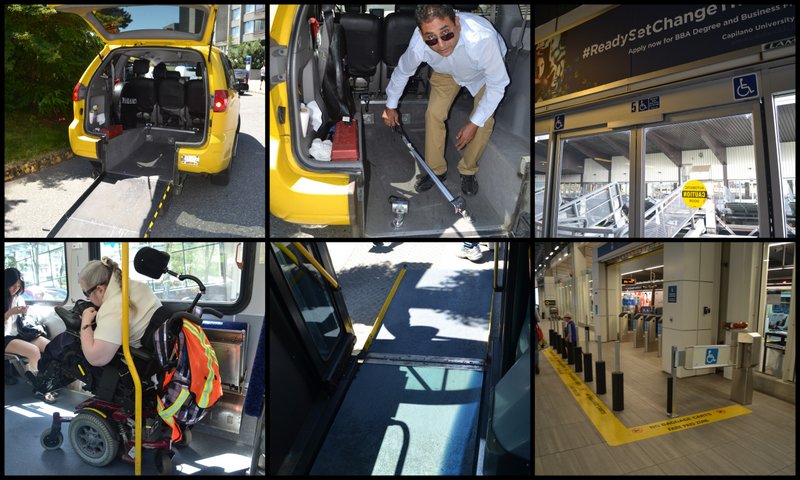 |
Clockwise from top-left: Specially designed taxis for the disabled; Prioritized entry for the disabled on the sea-bus (3) and the SkyTrain (4); Boarding is facilitated (5) and space created (6) for the disabled on buses.
|
UBC
During my first few days in Vancouver, I stayed at the University of British Columbia. UBC has an exceptionally beautiful campus. It lies on the shores of the Pacific Ocean, and is decorated by exquisitely laid gardens like the Rose Garden and the Nitobe Memorial Garden. The pedestrian-friendly roads, interspersed with patches of greenery, the lively library square- with sandbags to rest and socialize- add to the cinematic beauty of the campus. Even with my limited traveling experience I can wager it to be one of the most beautiful campuses in the world. Every public building in the campus is accessible. If any particular entrance is not accessible, there is a sign that directs an individual to the accessible entrance. For residential purposes there are various apartments that are specially designed for the disabled. The University lays special emphasis on sustainability as is symbolized by the architecture of CIRS (Centre for Interactive Research on Sustainability) – said to be one of the greenest buildings on the continent.
 |
Left to right: Automated fenestrations at CIRS respond to indoor conditions; view of Nitobe Memorial (Japanese Zen) garden in UBC; Rose Garden, the Pacific and surrounding mountain peaks.
|
Downtown
In my initial days in Vancouver the weather was extremely gloomy with incessant rains and the sun hidden behind the clouds. Vancouverites long for the sun, and love to talk about it. So, when it finally shone on the city, the whole city blossomed like a flower in spring, and became pleasantly buoyant. There were happy faces all around: on beaches, in parks, and roadside restaurants. Over the next few days I took the bus to Downtown and roamed around the city on foot. I conversed with people, clicked pictures, and checked-out public buildings. Other than the sun, Vancouverites love to talk about their city and the way it is evolving, and the problems the city faces.
Almost every day, I spotted people on wheelchairs roaming independently around the city. Vancouver has a highly developed pedestrian environment. It is deemed to have the highest number of kerb-cuts in the world. This enables easy access to virtually every footpath to the disabled. Most of the kerb-cuts had been laid in the early 90s. It was, subsequently, found that kerb-cuts can prove to be dangerous for people with visual disability because of a lack of appropriate warning. Therefore, as an afterthought, texture was added to the dropped-kerbs to warn blind people that they are about to step onto the road. To move from one footpath to the other, a network of traffic lights is functional in the city which makes a pleasant chirping sound whenever pedestrians are supposed to cross. This, of course, is to enable the blind people to cross the road without difficulty. It is pertinent to mention that two distinct kinds of sounds emanate at the traffic signals to allow blind people to ascertain the direction in which they can move.
 |
Left to right: Wheelchair users moving independently in Downtown Vancouver.
|
Early in my trip, I was benefitted by the company, assistance, and guidance of Leslie von Duzer - Director at School of Architecture & Landscape Architecture, UBC. As a result, my travelling became more streamlined. I visited the Vancouver Public Library (Library Square), Vancouver Art Gallery (Robson Square), and Waterfront Station-places which can be thought of as iconic of Vancouver- among many other places. These three buildings along with the Museum of Anthropology- with its muscular concrete posts that shoulder the protruding beams, reflecting the architecture of the cedar houses of the First Nations - and Beaty Biodiversity Museum – housing a 25-metre-long blue whale skeleton - have one thing in common: the entrance is in level with the ground. Doug, I am sure, would be in approval of that! The entrances to these buildings have push-buttons installed at appropriate heights to help the infirm/disabled to open the doors without any difficulty.
 |
Left to right: With corresponding entrances, Vancouver Public Library; Museum Of Anthropology; Beaty Biodiversity Museum.
|
Eyes on the Street
In the last semester I had taken up Ekistics as an elective and learned the nuances of human settlements. My travel through Vancouver gave me an opportunity to observe, first hand, the concepts that we had studied: Life in the suburbs; Designing for the pedestrians; Encouraging bicycle usage. Among the various perceptibly different things that fascinated me was the presence of surprisingly few number of shopping malls in Vancouver. The shops have been developed along the roads. I saw this as an exhibition of Jane Jacobs’ idea of ‘Eyes on the Street’ and, in my opinion it made the roads extremely safe. The provision of a secure environment in the city is equally important, if not more, as providing barrier-free spaces, for making a city truly accessible. Safe environments are especially important for people with disabilities as it is unusually tough for them to prevent themselves from any criminal attack. I never felt uncomfortable even in the shady areas of the city, which is something that I cannot say about Indian cities. I cannot help but compare the surge in the number of isolated shopping malls, with glossy but essentially introvert architecture, in Indian cities and the worsening safety situation therein.
 |
Left to right: Pedestrian only Main Mall (main road) in UBC; Robson Street near Robson Square (Downtown) is closed for traffic; Special lanes for bicyclists.
|
“Sports are sexy.”
During my stay in Vancouver I had the opportunity and honor of meeting many inspirational and pioneering personalities. Notable among them is Sam Sullivan. Sam is currently serving as the MLA for Vancouver-False Creek, and has served as the mayor of Vancouver. A skiing accident in his teens left him almost completely paralyzed. Instead of shunning himself to a passive life, he actively works towards facilitating better lives for the disabled in Canada and elsewhere. He has done pioneering work in rendering outdoor activities more accessible. Towards that end, he has established organizations like Disabled Sailing Association, Tetra Society, ConnecTra Society, Vancouver Adapted Music Society, BC Mobility Opportunity Society, and the Disabled Independent Gardeners Association. After a long discussion about the challenges one faces in ensuring accessible environments, and realizing that awareness was the primary factor that breeds such environments, I asked him what can be the best way to raise awareness about the issues of inaccessibility. “Sports”, he replied. “Get them to play sports. Sports are sexy. They grab eyeballs.” The argument goes that sports bring the disabled into the limelight, out of the marginalized corners, and forces the City to work towards accessibility. Incidentally, Sam was the Canadian Paralympic Ambassador for the Winter Games 2010.
 |
Meeting with Sam Sullivan, Prof. van Duzer, and Annie Boivin.
|
Whistler
International events, like the Olympic and Paralympic Games 2010, have been a blessing for the disabled. Nowhere was the effect more visible than in Whistler in wake of the Winter Olympics/Paralympics 2010. Whistler is a resort located north of Vancouver at the base of Whistler and Blackcomb mountains. The Village, as the center of Whistler is called, is linked by a pedestrian-only causeway called the Village Stroll. The Village Stroll flows like a river - contrary to the grid-iron pattern of Vancouver – with a spectacular view of the peaks and is delineated by a row of shops and restaurants. The fluidity encourages interaction amongst the visitors and residents, thereby highlighting the famous mountain culture and hospitality. A unique thing about Whistler is that it has been developed as a tourist destination for the disabled. I travelled from Vancouver to Whistler in a bus run by Greyhound Lines, Inc. Greyhound offers special services to facilitate the travel of disabled people. In addition to customer-support through its Disabilities Travel Assistance, it provides space to accommodate a wheeled mobility device, a service animal, a respirator, or even an extra passenger as essential-help at no extra cost. Once in Whistler, special maps, outlining all the accessible routes in Whistler are available easily at multiple places. The legacy of Paralympic Winter Games 2010, comprising of competitions like Biathlon, Alpine and Cross-Country Skiing, is conspicuous. Whistler Adaptive Sports Program- a society that provides year-round outdoor recreational programs for people with disabilities- is a glaring example. Founded in the year 1999, its activities- including Biking, Swimming, Kayaking, Canoeing, Hiking, Hand Cycling, and Snowboarding- got a boost after the Games. To supplement this, various private vendors have cropped up and provide opportunities like Zip-lining and Bungee-jumping to the disabled. Whistler provides an environment that inspires the disabled to live self-reliant, confident, and motivated lives.
 |
Clockwise from top-left: The Olympic plaza with the Paralympic logo in the foreground; information about accessibility maps; the lively Village plaza in Whistler; having to ask for directions encourages interaction; mountain biking and other adventure sports are popular; many people suffer from temporary disability due to the dangerous sports.
|
The Journey Ahead
Back in Vancouver I met Annie Boivin, who is working as an architect at Perkins + Will. While conversing, we took a stroll along the Seawall. Seawall, a scenic walk along the waterfront, is another characteristic feature of Vancouver that has been preserved due to the active participation of Vancouverites in the decision-making process pertaining to the development of the city. It offers a pleasurable and refreshing walk with enchanting views of the ocean and the mountain peaks. Annie was in her motorized wheelchair. She had received it from the government, she told me, after the previous one had broken down beyond repair. She could not afford a new one on her own. She went to the government. The government had two choices, in her opinion: Either she would remain without a wheelchair and be a burden on the state’s coffers as she couldn’t do the job of an architect without the required wheelchair, or it could help her in acquiring the wheelchair so that she could live a productive, ‘tax-paying’ life (which would reimburse the cost incurred by the government on the wheelchair in a few years). Better sense, thankfully, prevailed over the government! Annie’s story reiterates the importance of aware and assertive citizens.
 |
Seawall on the waterfront is a characteristic feature which adds to the beauty of Vancouver.
|
There was another important aspect that came to light during my conversation with Annie. I had been curious about the appropriateness of the various materials for making handrails, for wheelchair users, and put this question to Annie. Surprisingly, she said that she couldn’t answer the question from personal experience as she does not use handrails. Electronic wheelchairs with strong motors– like the one she uses- made handrails largely redundant. On the contrary, handrails are essential in Delhi where most people use non-motorized wheelchairs. It confirmed the idea that had been raising its head time and again during my travels: that the solutions that have been implemented in a developed city like Vancouver are not ideal for a developing city like Delhi. The focus, owing to the dissimilar nature of the problems, has to be different and has to respond to the specific context. I become conscious that my research, in order to be meaningful, should highlight the differences and try to find the adaptive alternatives that can work in an Indian setting.
I left Vancouver on 18th July with a heavy heart, fond memories, and new perspectives- not just on architecture but of life too. Reaching Delhi two days later, having traveled half way round the world and back, and stepping out of the airport into the city, I saw a disabled person rolling on a wheeled board using his naked hands over the road to thrust himself forward. He had to get down from the board, pick it up and put it on the footpath, climb over himself, and then get back in position to continue his ordeal. The journey ahead is long, for all of us!
|
|
|
 Like everyone else, this worker in Mexico needs transportation to his job. Public transport needs to be accessible for persons with mobility, sensory, and cognitive disabilities.  Persons with disabilities around the world are promoting transport systems that provide mobility for everyone. Mexican disability advocates are shown meeting with local transit officials to promote accessible transport. AEI has published guides to assist planners and advocates of inclusive transportation.  An accessible travel chain begins with safe streets and sidewalks. This street in Foshan, China, has separate rights-of-way for pedestrians, human-powered vehicles, and motor-powered vehicles.  Disability advisors at Rio de Janeiro’s Independent Living Center monitored access features for this street crossing, part of the Rio City Project.  Tactile guideways and tactile warning strips assist blind and sight-impaired pedestrians as well as others in Foshan, China.  Tactile warnings alert this blind person crossing a mid-street island in San Francisco, USA.  Busy intersections benefit from pedestrian controlled buttons and assist blind persons to cross through sound and vibration signals  Tactile warnings protect blind persons – and all other passengers – from getting too close to the platform edge in transit stations.  This footway adjacent to a road in Tanzania is protected by curb pieces which separate motor traffic from pedestrians and bicycles. Such basic safety measures are needed to prevent pedestrian injuries along roadways in many countries.  Even better, pedestrian and non-motorized traffic can be kept safely removed from motorized traffic by accessible sidewalks separated from the roadway, in this case by a well-designed drainage system along a main road in Tanzania. Speed bumps are used to slow traffic at crosswalks.  This pedestrian crosswalk provides level access to a bus island at an inter-modal transfer center in Mexico City.
Photo by T. Rickert, courtesy of DFID (UK) and TRL (UK). 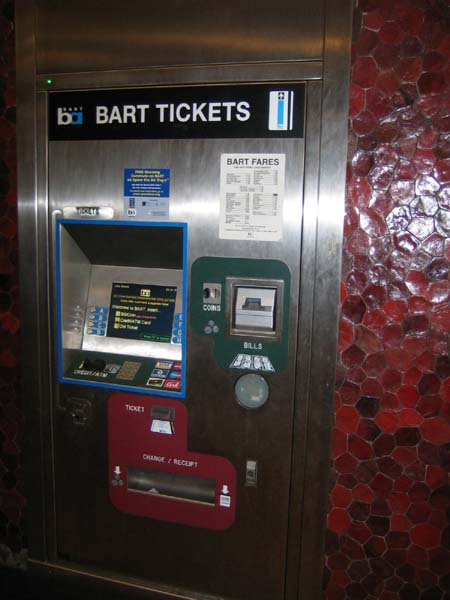 Ticket vending machines should be low enough for use by wheelchair users and all short persons, as illustrated by the good design of this machine at a BART station in the San Francisco Bay area, USA.  Stairs are often retrofitted with stair lifts in transit terminals, as here in a Tokyo subway station. However, in new construction, elevators should be considered where possible.  A wheelchair user takes the elevator from the platform level of the Shenzhen, China, railroad station.  Wide doors are needed to accommodate wheelchair riders entering fare-paid areas of transit terminals, as in this subway station in Rio de Janeiro. 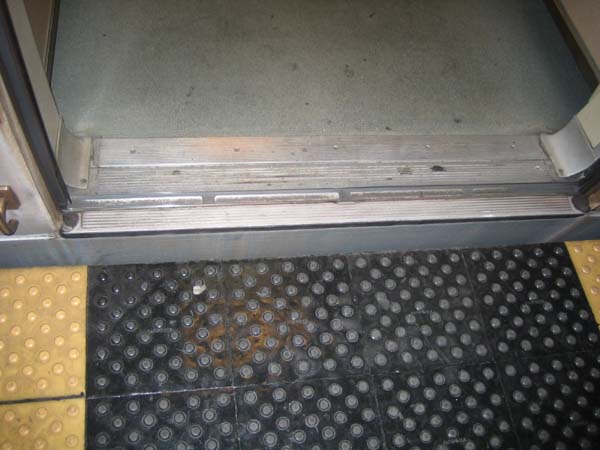 Everyone can safely board this BART train, due to a minimal horizontal and vertical gap.  However, care must be taken that horizontal gaps are not too wide. The orange “gap filler” pops up when the doors open in San Francisco’s Muni Metro, assuring a safe gap.  Small portable ramps can provide inexpensive access in many rail stations, as shown here in Tokyo.  All passengers, and especially deaf and hard-of-hearing passengers, benefit from well-located visual information, as with this route display on board a train to the Hong Kong airport.  Advocates Anjlee Agarwal (left) and Sanjeev Sachdeva board the accessible Delhi Metro on its inaugural run.
Photo courtesy of Sanjay Sakaria and Samarthya, from Amar Ujjala Indian Daily  Express buses in Curitiba, Brazil, exemplify universal design. All passengers, including those with disabilities, quickly board with level entry. Similar Bus Rapid Transit (BRT) systems operate in Quito, Ecuador; Bogota, Colombia, and a growing number of cities around the world.
Photo by Charles Wright, Inter-American Development Bank.  Construction of this Bus Rapid Transit (BRT) trunk line corridor in Pereira, Colombia, symbolizes the rapid spread of BRT systems around the world. BRT systems lend themselves to universal design, but details must be monitored carefully to maximize accessibility.  Although most BRT busways are on broad thoroughfares, this exclusive single-direction bus lane nearing completion in Pereira illustrates that BRT systems can sometimes be built on narrow streets.
This and above photo by T. Rickert courtesy of World Bank  The photo shows an articulated bus docking at a Bus Rapid Transit station in León, Mexico.  Pre-paid passengers inside a station board a high-capacity BRT bus in León.
This and above photo courtesy of Sistema Integrado de Transporte Masivo de León 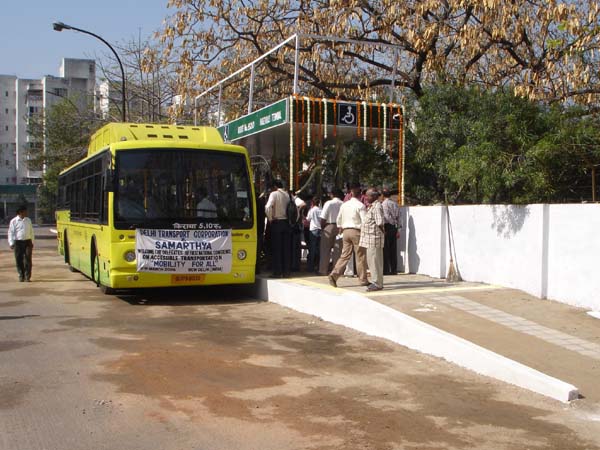 A prototype low-floor bus is tested in New Delhi adjacent to a platform the same height as the bus floor. 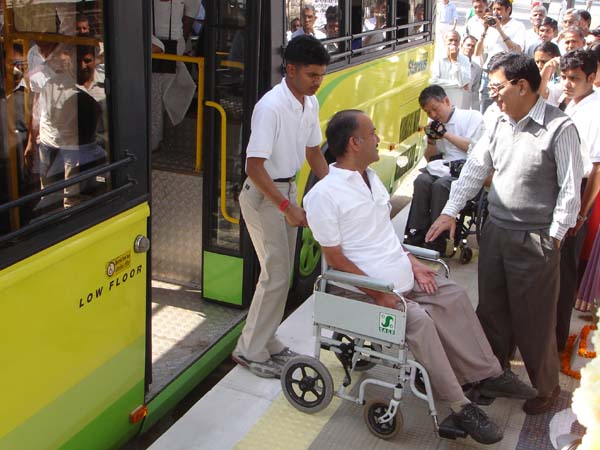 A closeup of the same bus stop illustrates the advantages of fast boarding for all passengers from platforms that eliminate the need for climbing steps to board.
This and above photo courtesy of Gerhard Menckhoff of the World Bank.  This prototype lift-equipped bus serves Mamelodi Township in South Africa. Note the excellent use of contrasting colors.
Photo by T. Rickert, courtesy of DFID (UK) and TRL (UK).  Mexico City officials inaugurated service in 2001 with 50 new buses equipped with lifts and other access features.
Photo courtesy of Marìa Eugenia Antunez.  In addition to a wheelchair lift, this bus in Mexico City has a retractable step beneath the front entrance.  This low-floor bus in Warsaw, Poland, uses an inexpensive hinged ramp which provides easy boarding for passengers with disabilities.  A low-floor bus in Hong Kong also exhibits excellent color contrast, using a bright yellow on key edges and surfaces.  Transit systems around the world have reserved seating for seniors and passengers with disabilities, and often for pregnant women as well, as found on this TransMilenio bus in Bogotá, Colombia.  Even when bus stops are not accessible to wheelchair users, access for seniors and others with disabilities can be enhanced by a level all-weather pad even in the absence of paved sidewalks. The photo is from a TransMilenio feeder route in Bogotá.
This and above photo by T. Rickert courtesy of World Bank.  Thousands of Mexico City’s small inaccessible microbuses are being recycled and replaced with larger vehicles, often with better access features.  One such feature is this priority seating located behind the driver where there is extra leg room and it is easier for blind passengers to hear the driver call out key stops.
Photo by T. Rickert, courtesy of DFID (UK) and TRL (UK).  In other new buses in Mexico City, a wide rear door has low steps and is easily accessed by semi-ambulatory passengers from a raised sidewalk, but requires that drivers carefully pull in to the curb.
Photo by T. Rickert, courtesy of DFID (UK) and TRL (UK).  Community initiatives are playing a growing role in providing accessible door-to-door transport in many countries. This accessible van in Kuala Lumpur, Malaysia, belongs to the six-vehicle fleet of Persatuan Mobiliti.
Photo courtesy of Persatuan Mobiliti  Artist’s conception of a three-wheeled door-to-door vehicle connecting with an accessible ramped platform with bridge at a bus stop at a key site.  This prototype three-wheeled vehicle was built with AEI’s assistance by Kepha Motorbikes in Nairobi, Kenya.  Detail showing entry via a ramp at the rear of the test vehicle.
This and above photo courtesy of Wycliffe Kepha.  This accessible bicycle rickshaw in India has a rear door which serves as a ramp.
Photo courtesy of Bikash Bharati Welfare Society and Lalita Sen.  A public meeting in Cali, Colombia, discusses accessibility to Bus Rapid Transit systems. Readers can go to the Bus Rapid Transit Accessibility Guidelines in our Resources section, under the links to the World Bank.
Photo by T. Rickert, courtesy of the World Bank. 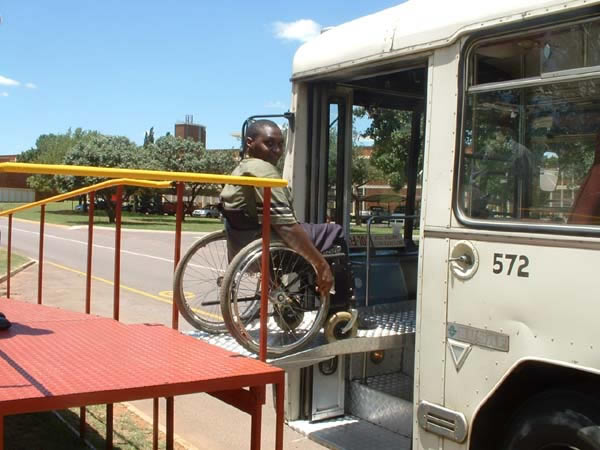 In this version, the bridge piece is mounted under the platform and put into place by the bus driver.
This and above photo courtesy of DFID (UK) and CSIR Transportek (South Africa). 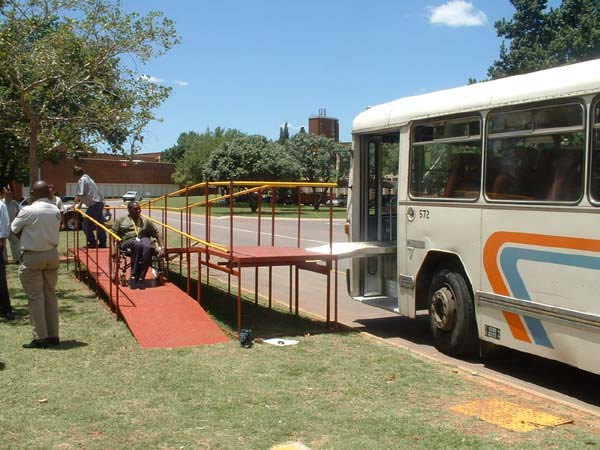 This test in South Africa of a prototype platform for use at key sites shows an alternative approach to access for wheelchair users.
|
|























































